though the length of europe, morocco and western sahara
First visit to the African continent, winter 2012
We totaled 3.945 km. in Morocco and the Western Sahara during our seventeen days there, it equals 232 km. per day, and the total drive time was 77 hours making it around 4,5 hours per day.
After exploring the desolated interiors of Iceland on two separate occasion´s in my Volkswagen Touareg I found myself longing for another type of adventure, something different and also more demanding. After reading about Tom Sheppards adventures though the Algerian desert in his Geländewagen in his book "Quiet for a Tuesday", and then some additional investigation and blog-reading I decided that an adventure into Western Sahara would fit my dreams just nicely. Since I never have been in Africa going single-handed into the desert seemed at bit to challenging so I hooked myself up with a British guide, Paul Blackburn who leads expedition trips into Western Sahara with his firm OneLife Adventure. When travel was paid, settled and planned for, I suddenly found myself reflecting a bit about my truck at that time, it´s size and it´s off-road capabilities.
Although my Volkswagen Touareg performed quite well on my Icelandic adventures, I felt that I needed a more roughed vehicle, also I had grown into the liking of these vehicle supported expedition-like adventures. After a short while my mind was set firmly on a Mercedezs Benz Geländewagen. Long story short I ended up fetching myself a model year 2005 G400 CDi Limited Edition in Germany and importing it myself to Denmark. A choice I have never regretted, I have always had a soft spot in my heart for this hard-edged, flat-panelled truck.
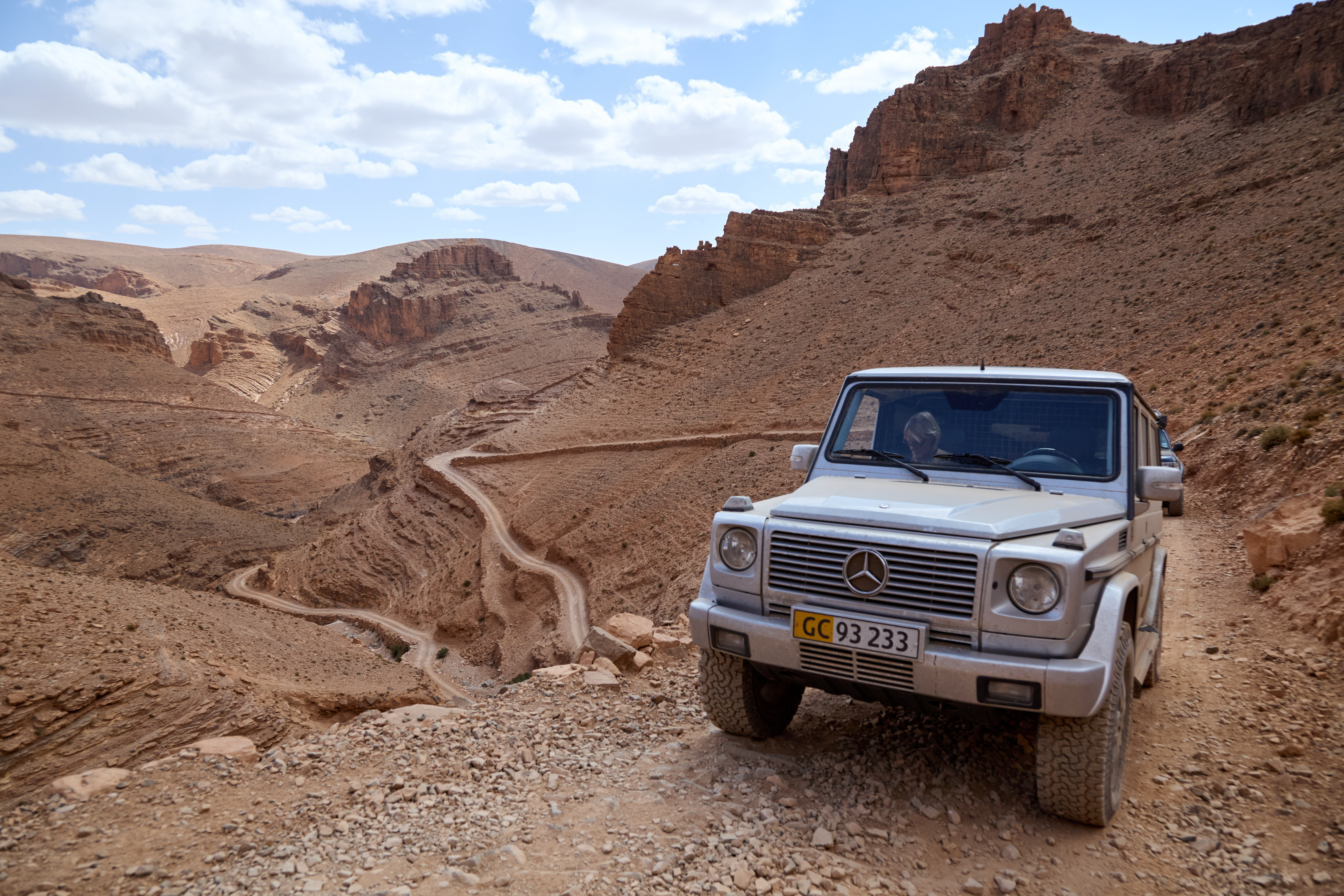

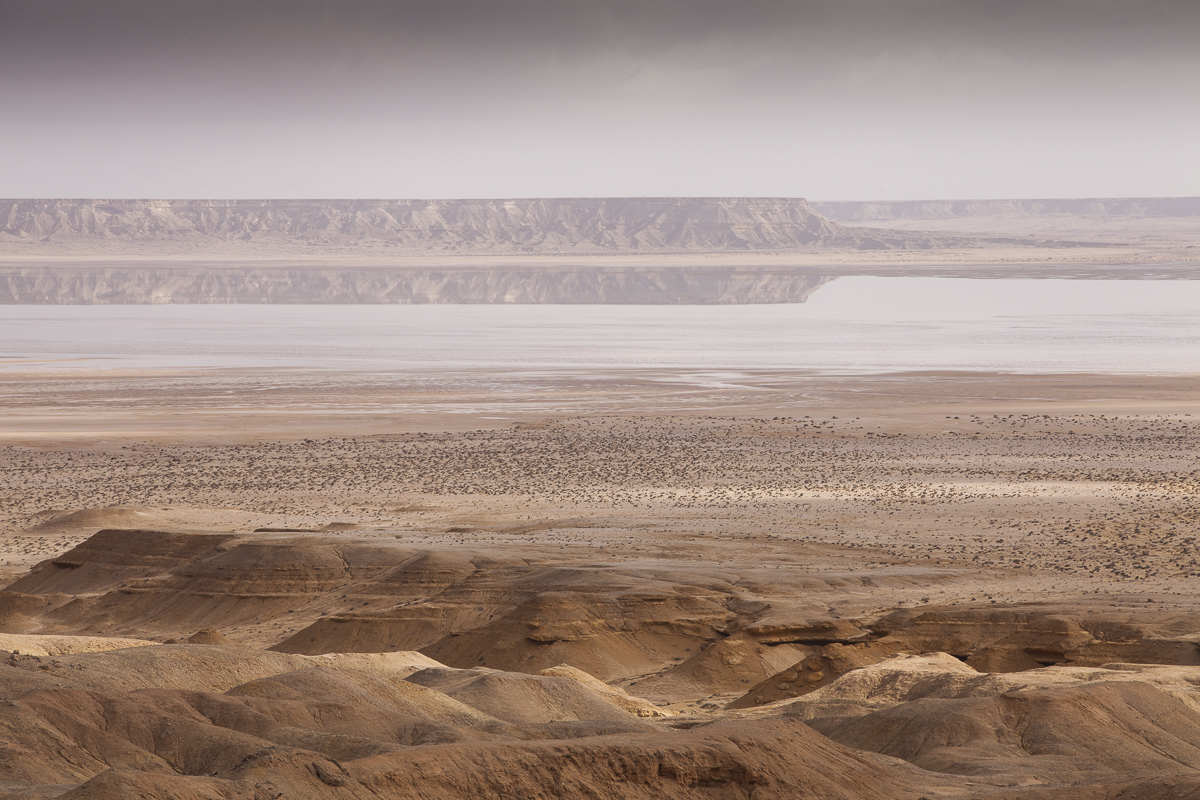
The drive from Denmark down though the February cold and dark Europe to the warmth of Southern Spain to the rendezvous way-point with the travel-party and the guide was completed with only two hotel stop-overs, one in Southern France not far from the Mediterranean Sea and one in Central Spain, and we still made it in god time before deadline. We took off from my home in Elsinore late one evening with a short stop-over in Copenhagen and then went on determined to eat up most of Germany during the night. I very much prefer driving through Germany at night because of the low traffic-density and the fact that there´s seldom any traffic-jams as a payoff. My only concern really is to keep clear of Hamburg when office hours ends, but sometime after six o´clock you´ll be fine. Since I at the time of leaving only have had my Geländewagen for a very short period of time I was not to familiar with the command navigation system and I therefore had neglected to tick on a setting somewhere in the menus correctly, so we ended up taking a unplanned short detour onto a few secondary roads in Switzerland just on the brink of daylight.
I had a hard time forgiving myself for this mistake as it did cost us at least an hours time-loss, but finally we were on the right path again and were enjoying the nice auto-route network that France has to offer, destination Marseille and beyond. Progress was good with nearly no traffic and we were blessed by some lovely rays of sun from the rising fireball in the horizon. The power and the at all-times present huge torque from the four liter twin-turbo diesel V8 combined with the perfect multi adjustable contour-seat made high-speed auto-route cursing untiring and pleasant and I easily did 22 hours of nearly non-stop driving most of them at 130 km/h on the German autobahn and the smooth auto-routes in France.
The meet-up way-point with the travel party was a nice camping site on road N340 just west of Tarifa in Spain; in order to get to know each-other we all had diner and beer together the first night, and with ambient temperatures around 12 degrees Celsius, it was a nice change from the winter sub-zero temperatures we luckily had left behind in Denmark. The other members of the party as well as the guide were all Englishmen, and a single wife. Aside from my Geländewagen the trucks were different Landcruisers and a single Defender 110", the party consisted of a total of 4 trucks plus the guides Landcruiser 80 series.
Getting onto the ferry the next morning was fairly stress-less although we did drive around a bit in the harbour in order to locate the ferry; but all the hassle in customs in Morocco at the Tangers Med Port with passport and vehicle paperwork was quite annoying, all my worst prejudgements was fulfilled, - any real efficiency was non-existing at the border crossing, it all seemed to happen in random order. You will need at least around half a day to enter and to leave Morocco I´m afraid. Life will be a bit easier on you if you have prepared a form for the temporary import of your car (pdf-file can be found on-line). After struggling through customs we stopped a short distance away in order to exchange some currency, as you are not allowed to bring any local currencies into Morocco this task can not be bypassed, but we quickly exchanged some Euros in a small office just on the brink of the harbour. And off we went into Morocco wearing sandals and t-shirts, huge smiles on face and open sun-roof on truck.
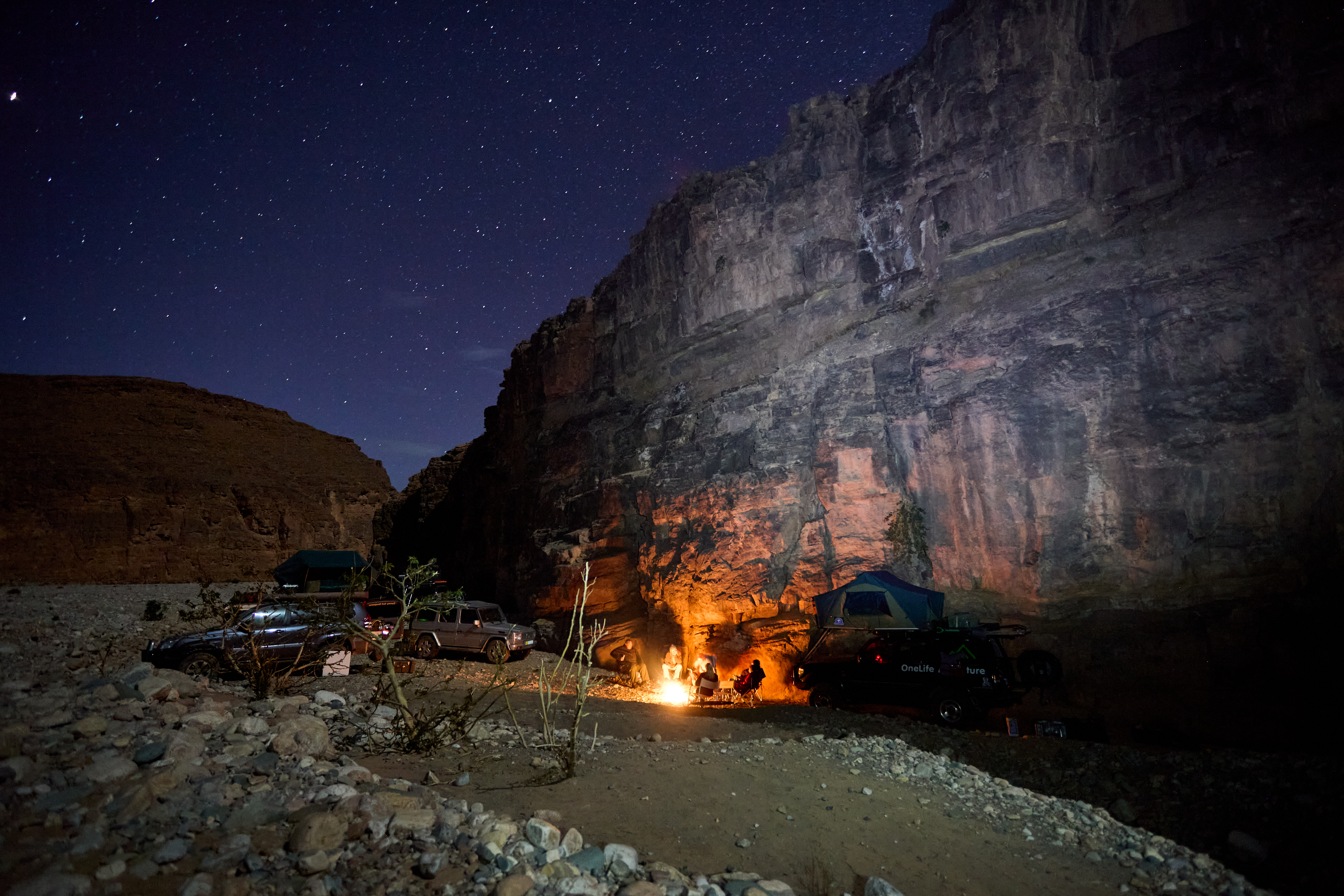

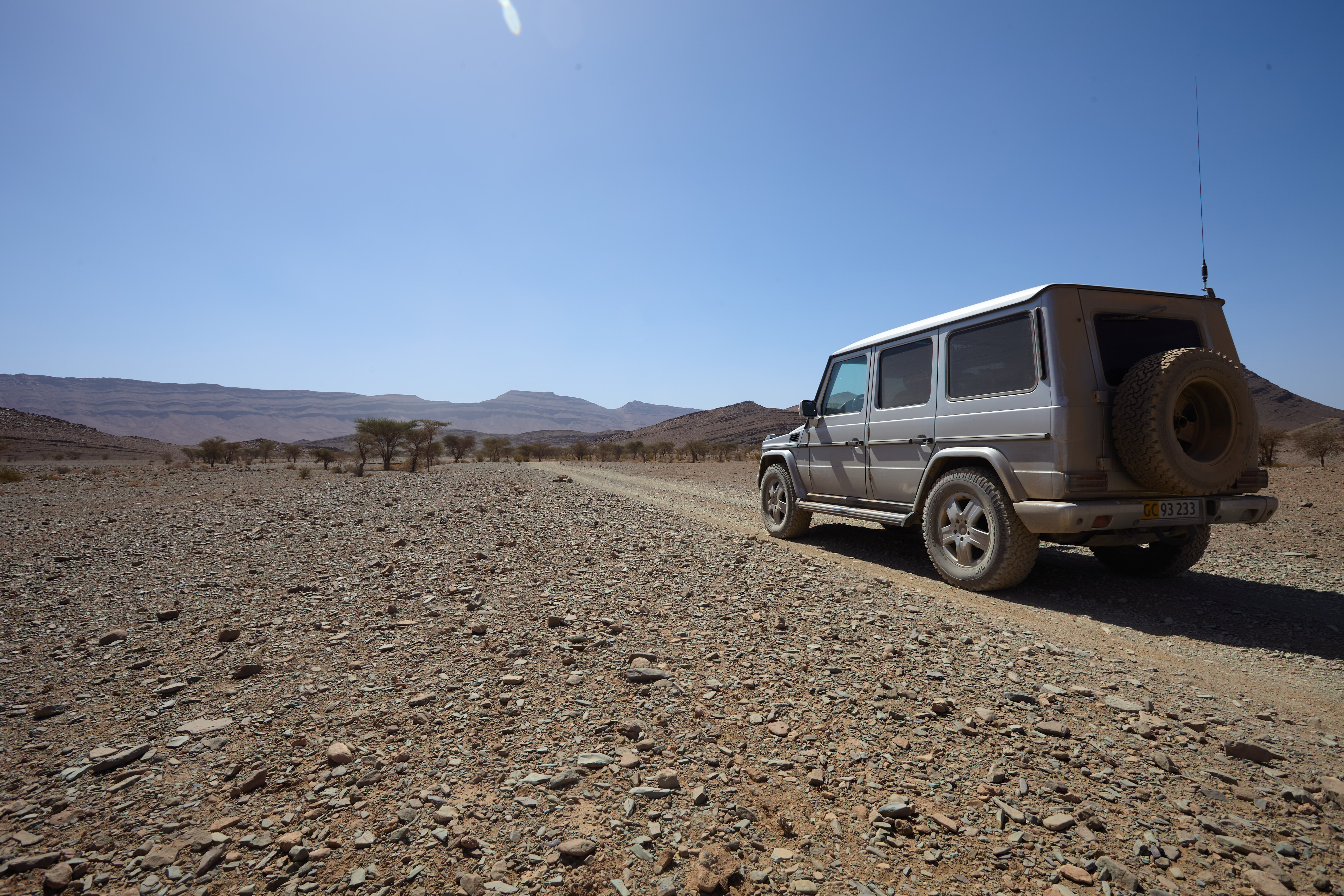
For the trip I was running BFG AT tires in size 285/60-18, equal to 33", stock tire size is only 31" and I´m not sure the 31" on this occasion would have allowed me to have enough surface to get out of this trouble on my own.
The cities and some of the coastline in the north is a mess and somewhat untidy as Morocco has no real efficient rubbish removal system these days, and hence some litter lies around in the countryside and in villages. But still that won´t change the fact that Morocco and Western Sahara is a paradise for driving off-road and the nature is quite spectacular here. The High Atlas and Anti Atlas mountains as well as the desolated plains of Western Sahara is a dreamland for nature lovers. During the entire round-trip we camped wild in nature, and the quiet evenings around the bonfire were absolutely lovely. We were often totally alone during the daytime and in camp at night, a few shepherds did guard their wild stock but they were scattered around in the countryside. From time to time we did meet some locals herding mostly goats or driving around in very old Land Rover Series I and II and on a few occasions they would ask if we could offer them some water or fuel. Morocco and Western Sahara is a mixture of places with big beautiful nature with total quietness and cities filled with fuss in marketplaces and great noise. I surely prefer the quieted places in the back-country.
People are certainly not rich in the interior regions of the country and we did encounter a few kids who were begging in the smaller cities. But people was mostly very friendly and interested in what we were doing and where we come from, and the military and the police officers were all polite, helpful and easygoing when we encountered them at checkpoints. Only on a few occasions did we had kids throwing stones at our trucks when driving through the small villages, this is sadly a known issue in northern Morocco. If you can speak a bit of French conversation with the locals will be a lot easier, but most police officers and the military personnel did speak some basic English.
On the very first day we made it a bit south into Morocco and stayed the night in a big cork oak wood not far from the motorway at Kenitra some 218 km. south of Tanger Med Port. The A1 motorway is in excellent condition with smooth tarmac and very clean and will get you south quickly, also there´s some really well supplied gas stations along it often also with WiFi, but you do have to pay road tax. The plan was to by-pass the High Atlas mountain range via the motorway in order to get into Western Sahara swiftly, after all Western Sahara was our main goal for this adventure. The second day we were served tarmac also digging us some 566 km. further south via the motorway network and we reached night-camp at Ameskroud in a rock- and stone filled camp at a riverbed with a now dried out river. Some efficient team-work was done and we shortly after arrival had a nice bonfire going to cook our meals on and to stare into in total relaxation and also a bit of awe of finally being here in North Africa. It was a relaxing evening with a few beers and lots of chatting.
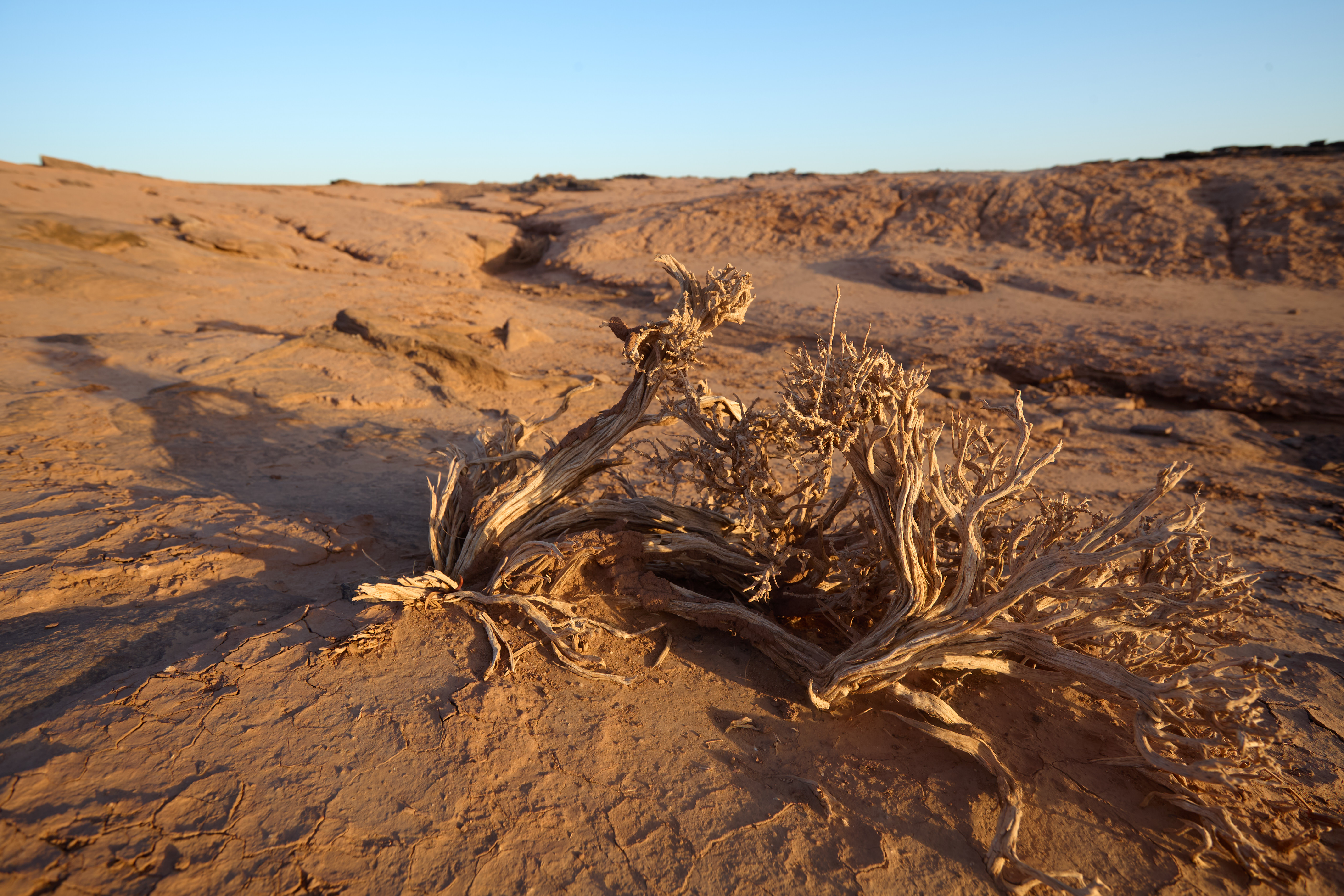
On the next day after a few hours on tarmac we finally did drive some adventurous pistes on our heading towards Western Sahara, and also a bit of back-tracking when things got out of hands and did not go as planned on the maps. That night we therefore had to sleep over one very cold night in the heights of the Anti Atlas mountains at Talat Zagat where temperatures sunk below zero degrees cecilus. That night I really appreciated the fact that I slept inside the truck on my nice soft foam-mattress bed and had the opportunity to let the Webasto heater burn from time to time, while the other members of the party where cold in their rooftop tents. That evening we decided to skip the bonfire, it was very chilly and a freezing breeze swept the mountains in an very cruel and unpleasant manner.
After the cold night in the Anti Atlas Mountains we headed on into some beautiful scenery and onto a tiny rock filled mountain-piste leading to an abandoned village in the mountains and onwards via a rarely used track in a dried out riverbed. We drove all day off tarmac on some stunning gravel tracks in the Anti Atlas mountains between steep hillsides with beautiful curved patterns originating from the folding of rock that occurred so many years ago during the creation of this mountain ridge. We found a nice spot close to a hillside a few kilometers from the road to make camp for the night near Tizga Ida Balour. At a previous pause that day during the drive we had collected some pieces of wood to make a bonfire for the evening, the landscape and scenery was getting drier and wood was becoming a rarity. We had another nice evening at the fire cooking dinner and talking about the events and impression of the day on the piste. This drive of the day is supposedly the longest you could have in the Anti Atlas off tarmac and we only did a total of 77 km., but what lovely ones.
We woke up to a beautiful view to the Anti Atlas and a very sunny day again, doing our now more or less standard routines, clean up, have breakfast and coffee, pack up and go for an another adventure. This day was mostly gravel pistes with tiny stones and we eventually left the Anti Atlas and headed into more level terrain passing villages and small oases with palm trees, ancient buildings and aged water supply systems. Camp for the night was set up away from the piste close to another dried out riverbed at Oued Tigzert. Today´s distance covered was 277 km. indicating a more even surface.
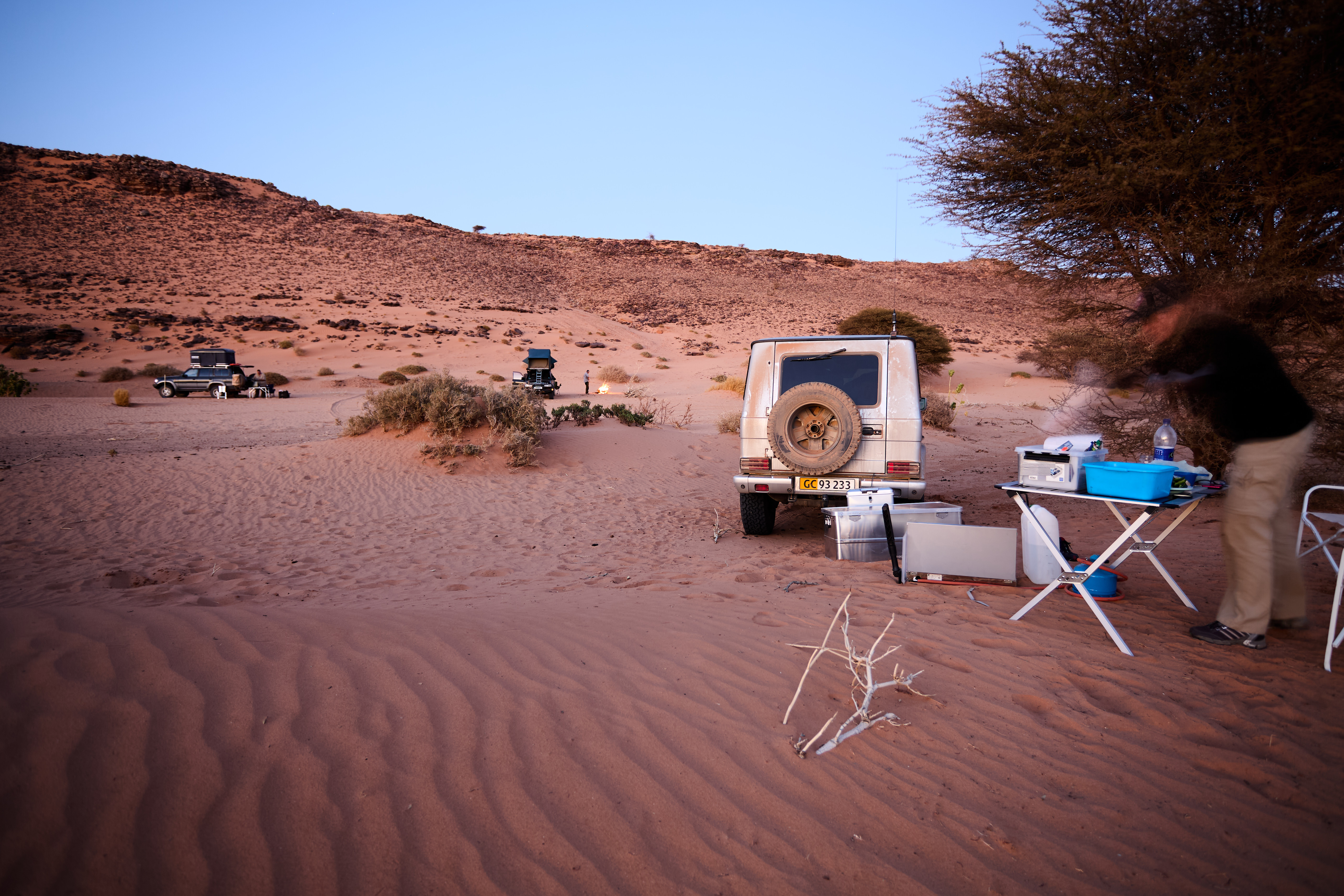
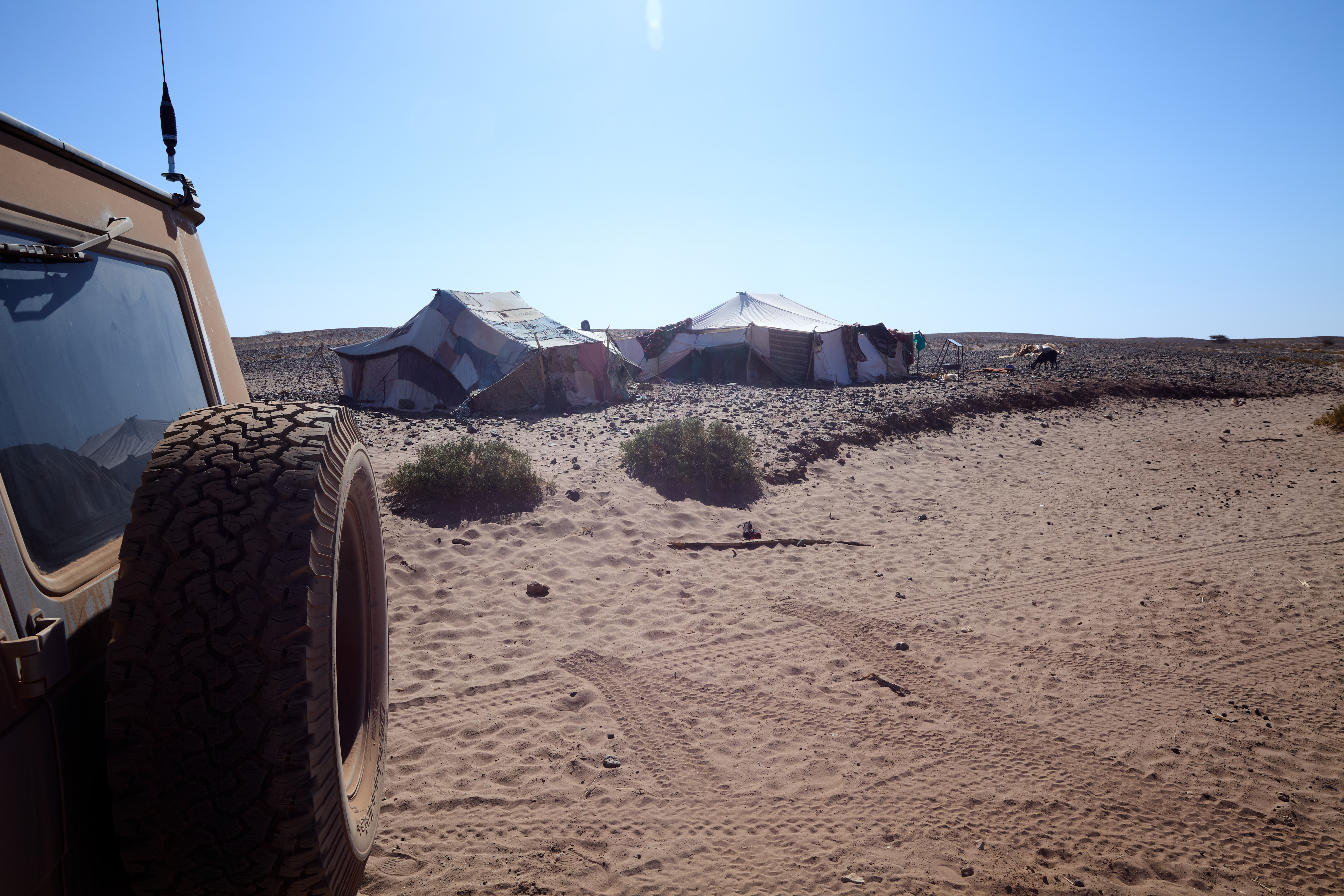
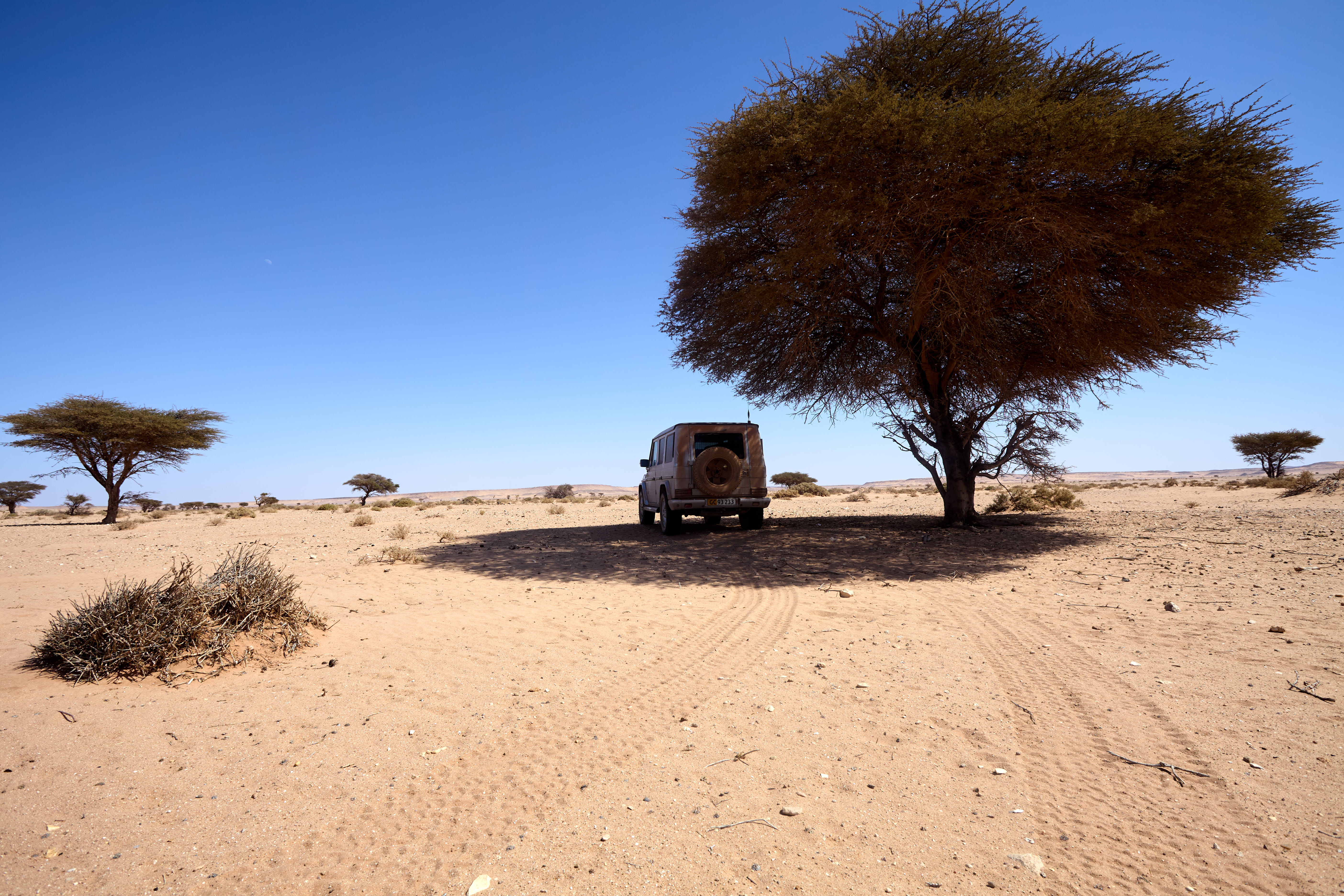
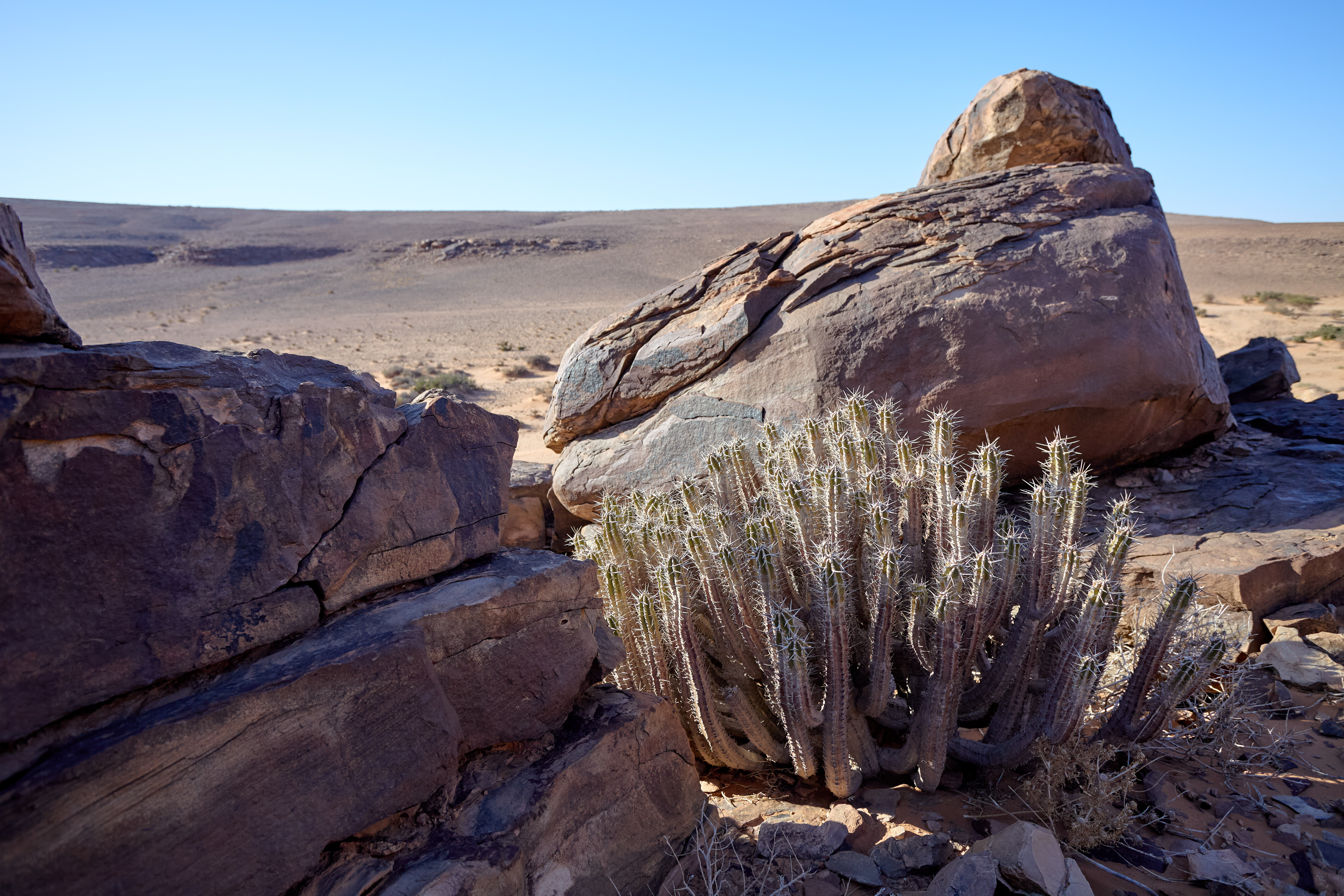
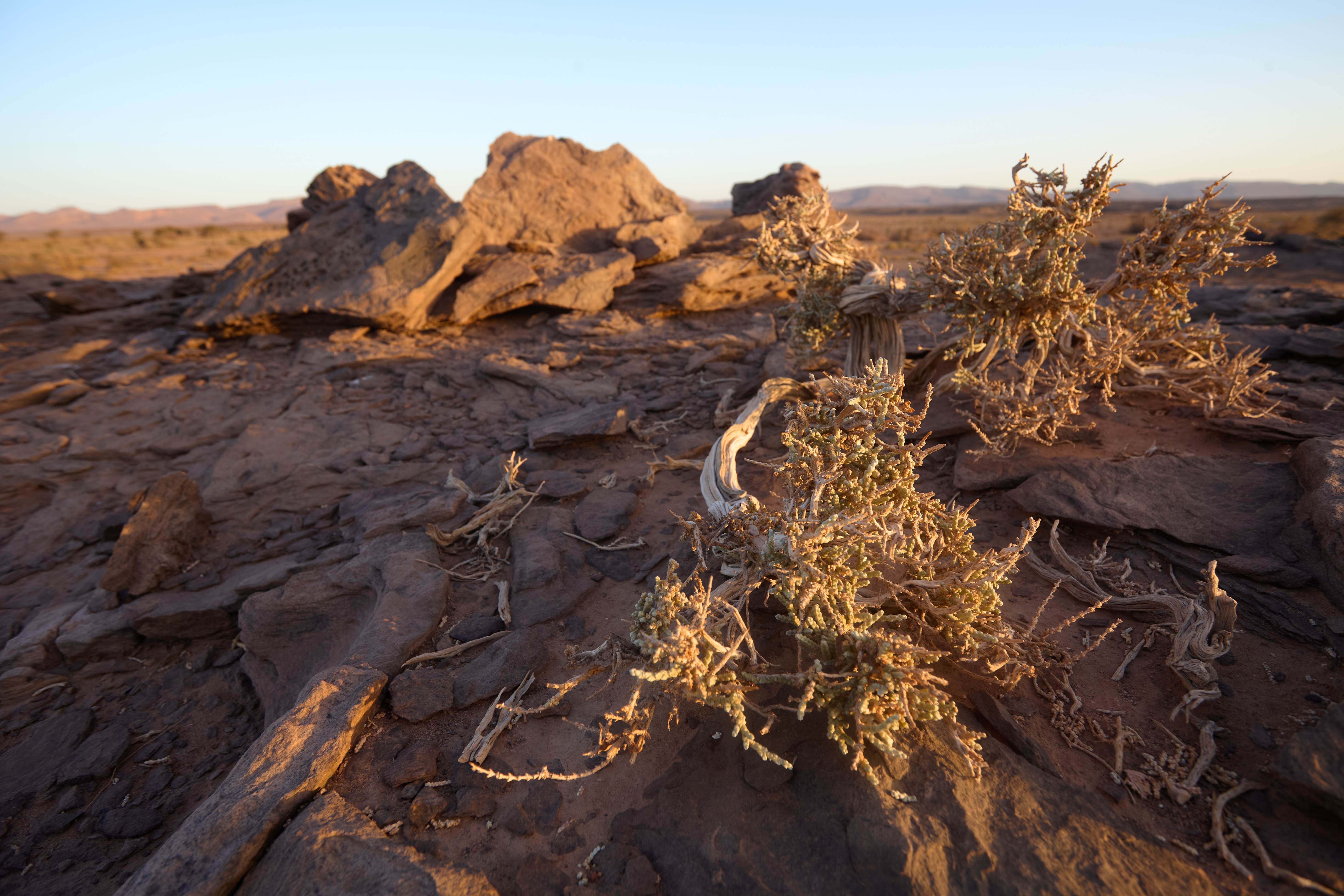
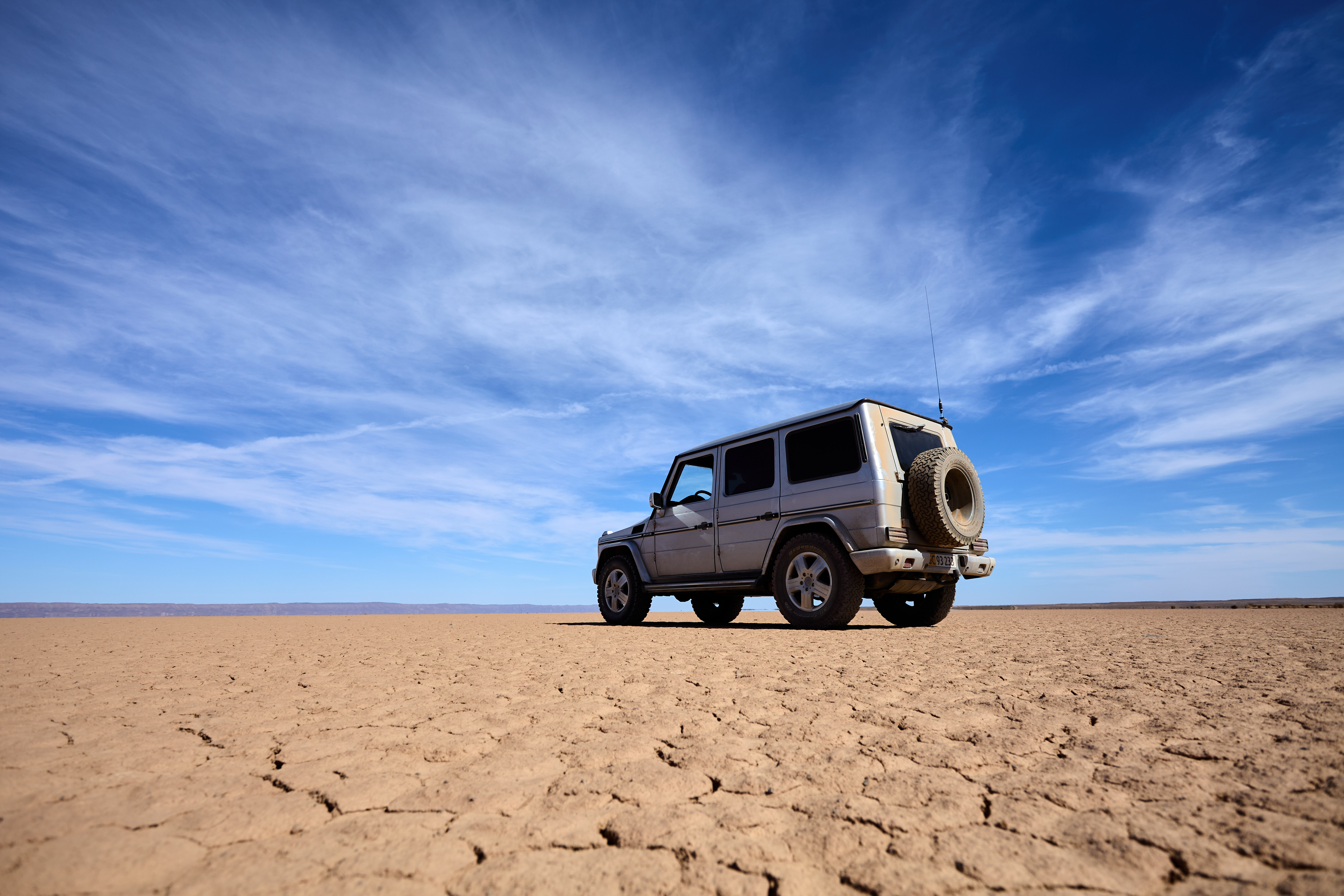
I had four 20 liters Jerry-cans with me for additional fuel supply, and for the longest duration away from fueling stations I had to empty two of them. I also had three 20 liters Jerry-cans for drinking water.
Day seven dawned after a quiet night with some nice and well deserved sleep, all blue skies above us and no winds. On our way out off camp and unto the piste I manged to get stuck in some deep loose sand following the tire-tracks from the previous trucks, and we had to do a bit of digging and also lower tire pressure two times in order to get my Geländewagen out of the sand without any other assistance than a bit of manpower, I think I ended up with a tire-pressure as low as 8 PSI and naturally I did some smooth and gentle steering corrections to make sure the tires hopefully would stay on the rim. For the trip I was running BFG AT tires in size 285/60-18, equal to 33", stock tire size is only 31" and I´m not sure the 31" on this occasion would have allowed me to have enough surface to get out of this trouble on my own.
Being close to the border to Mauritanian we had to travel in a more westerly heading in order not to get in trouble when getting to close to the border. There´s still some potential danger here where the Morocco military makes an effort to prevent people from crossing the border from Mauritanian and into the Western Sahara. This area alongside the border has a long sad history filled with troubles and a lot of tension. We covered 128 km. of beautiful desert, dried out lakes and saw a few lonely old graves in the middle of nowhere and closed the day off at another nice wild camp at Garet Lamhor where we encountered a stunning sunset, and sunrise as well.
This day on our way for a bit of civilization and stock up supplies of fuel, water and food we passed another dried out lake. After filling up the fuel-tanks, jerrycans and the fridge/freezer we headed out of town again in the afternoon to search for some remote and rare rock-art. To see and touch upon this old rock-art was an awesome experience and we spent a few hours in that spot in order to have time to quietly take in all in. It´s mind-blowing to think about the changes the Western Sahara has seen over the span of the lifetime of Homo-sapiens, the engravings displays pictures of now exotic animals to this area, like giraffes, elephants and antelopes. You can tell that the rock-art has been created over a longer period of time, some of the engravings were nearly washed out over time by sandstorms, others were more defined and therefore must have been made in a much later period. We eventually had to head off to make wild-camp for the night somewhere south of Smara clocking 145 km. that day.

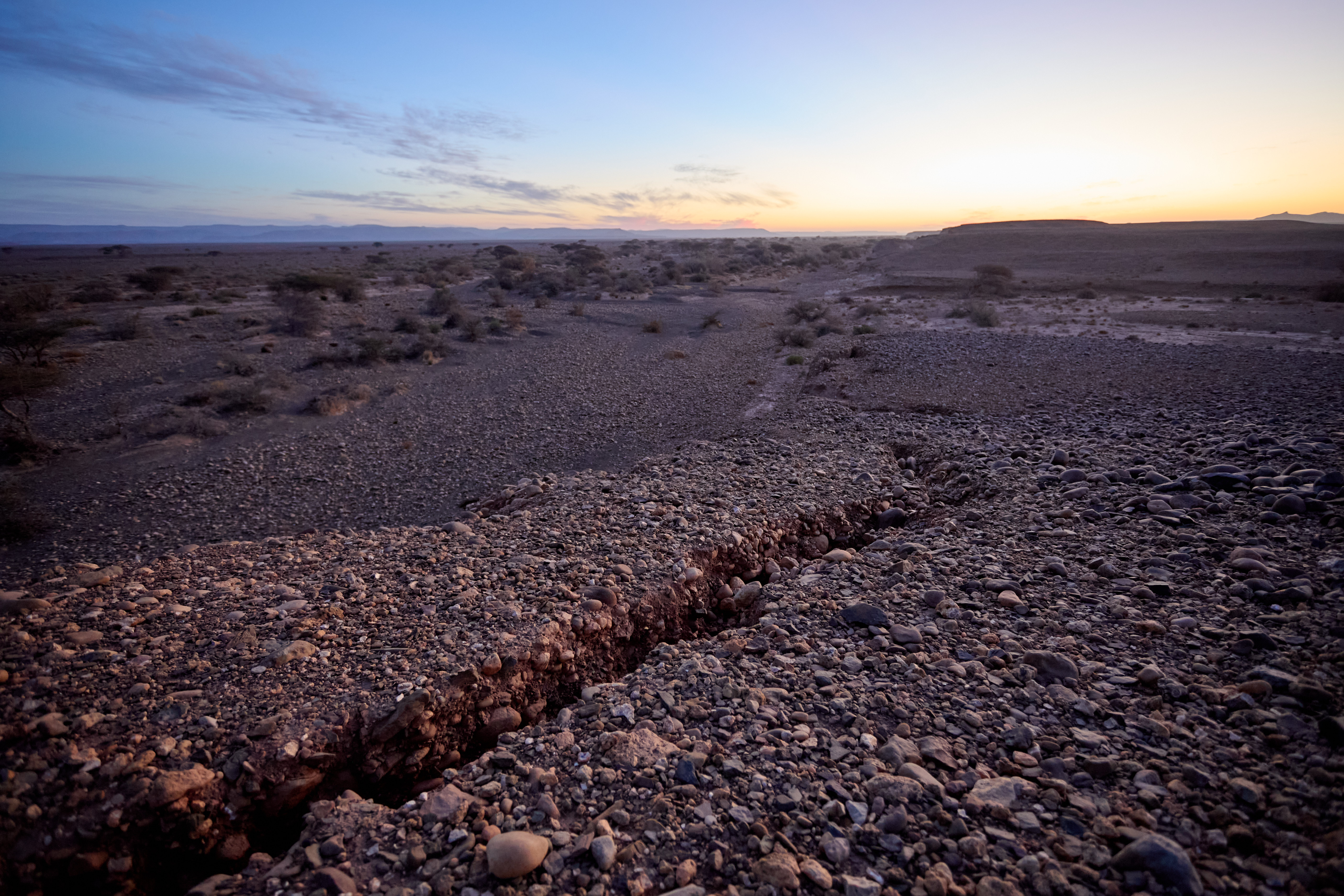

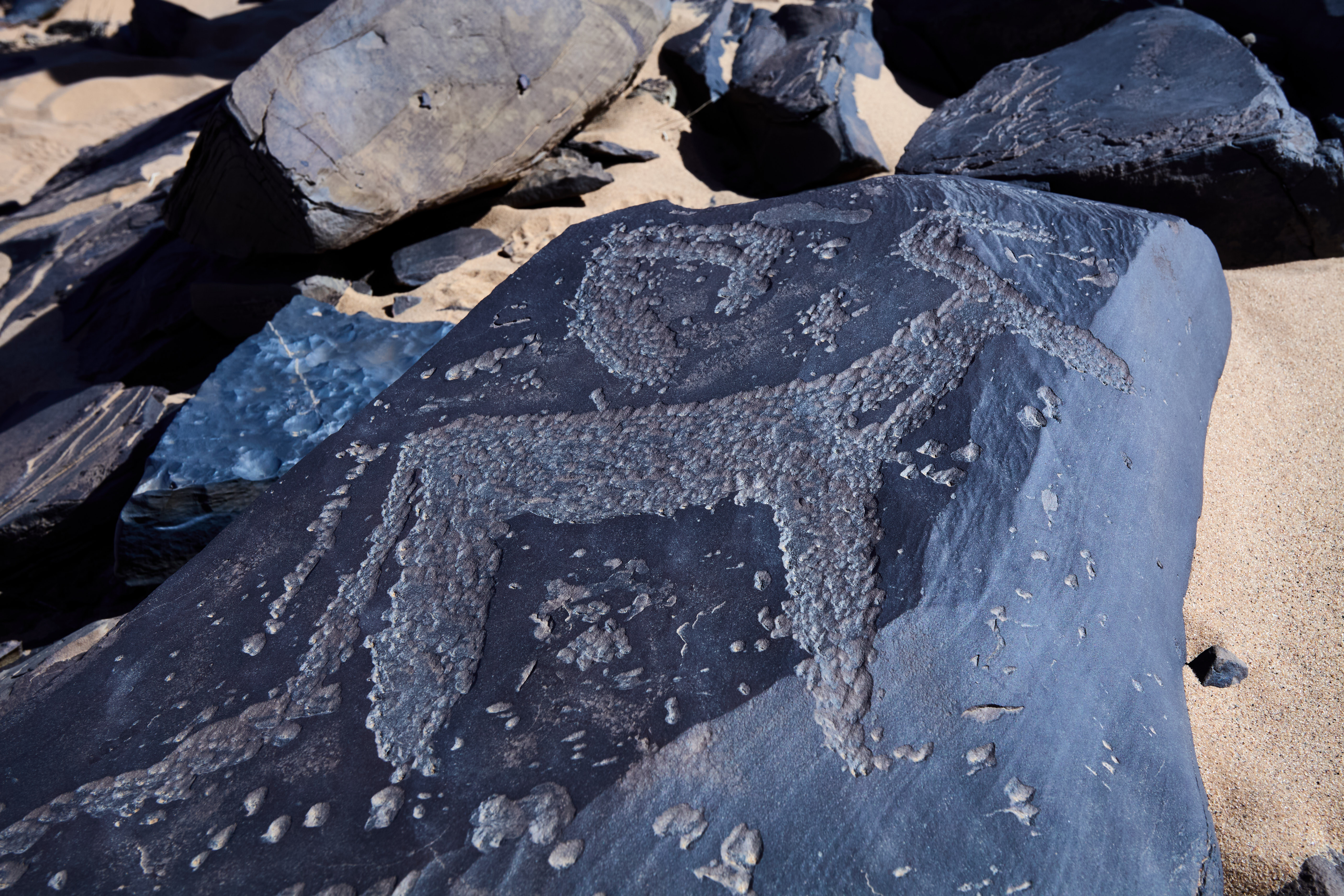
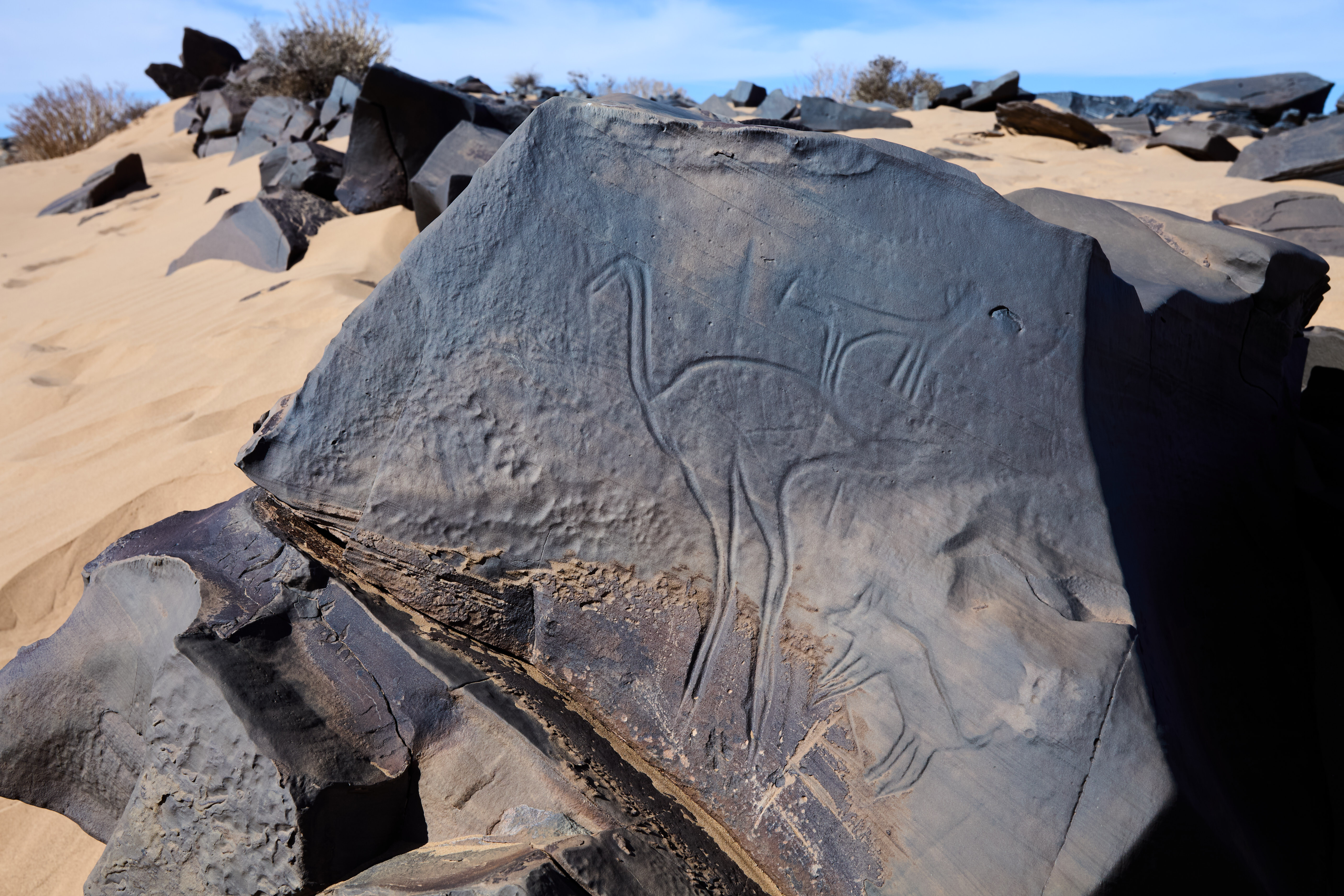

On most mornings we had enjoyed blue skies and sunshine but on the morning of this day, we woke up to a unexpected fog blurring the features of the landscape, and naturally temperatures were in the lower end. The Western Sahara never ceases to surprise you.
On most mornings we had enjoyed blue skies and sunshine but on the morning of this day, day 9, we woke up to a unexpected fog blurring the features of the landscape, and naturally temperatures were in the lower end. The Western Sahara never ceases to surprise you. Still being in the Western Sahara territory we now drove on a more westerly heading with the purpose to at some time reach the coastline to the North Atlantic Ocean which we would follow when we eventually would have to head back north again. We stopped and paused at a lake filled with sulphurous dissolved water, and for the first time after a long time in the dry desert we saw more than a single bird at the same time. An old Land Rover Series I was parked at the lake and a few very aged locals asked us to spare some fuel, they also seemed to be wanting the jerrycan as well, but we would need it ourselves so they had to be content with the 20 liters of diesel we offered to them. Conversation was quite difficult as they only spoke Arabic dialects it seemed. We headed on for a few hours and made camp at Dra Affrafir after a total drive of 276 km. for the day.
On day 10, March 5th we woke up at the sand dunes at Dra Affrafir and we spent all morning until lunch-time practicing some serious and challenging dune-driving. It was quite fun and a great experience to try to tackle the approach to the summit of the dunes with the right amount of speed and momentum, if you did not succeed you would either get stuck up-hill, get stuck on the crest of the dune or carry to much speed going down on the backside of the dune, the later being the worst scenario. We all succeeded in getting stuck a few times and had to be pulled out of our misery by another truck with the assistance of a kinetic rope, but that aside no real accidents occurred. That night we slept at Sebkat Arridal after a relatively short drive of 106 km., all of them done mostly after lunch and the dune surfing.
The following morning greeted us unexpectedly with a cloud-filled sky and we had to put more cloth on our now suntanned bodies than the usual t-shirt. We made our way out of the Sebkat Arridal and followed a piste going around it. We later ventured into it in another spot and here different plants and flowers were actually able to survive. There was also some spectacular colorful layers in the rock and cliffs surrounding the lower plateau. Onwards was another huge sunken seabed which we unfortunately did not have time to investigate further than overlooking it from above, I´m pretty sure this will be worth a return trip to that area for a closer study, but we were on a schedule and pressed on to be able to reach the ocean later that afternoon and have time enough on our hands to do some wave dodging. We did an over-night stay close to the beach west of Dawra after covering 266 km. for the day.

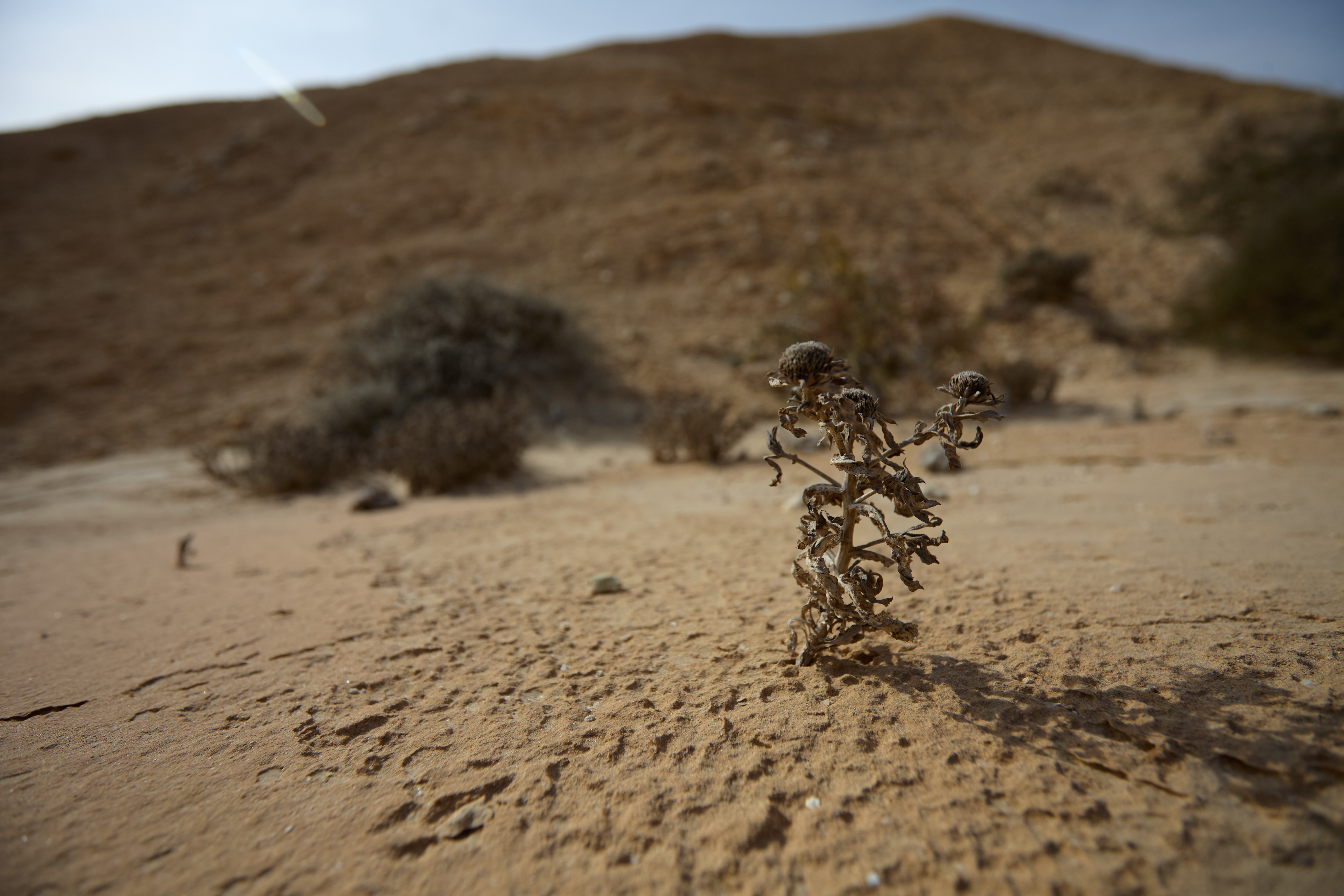

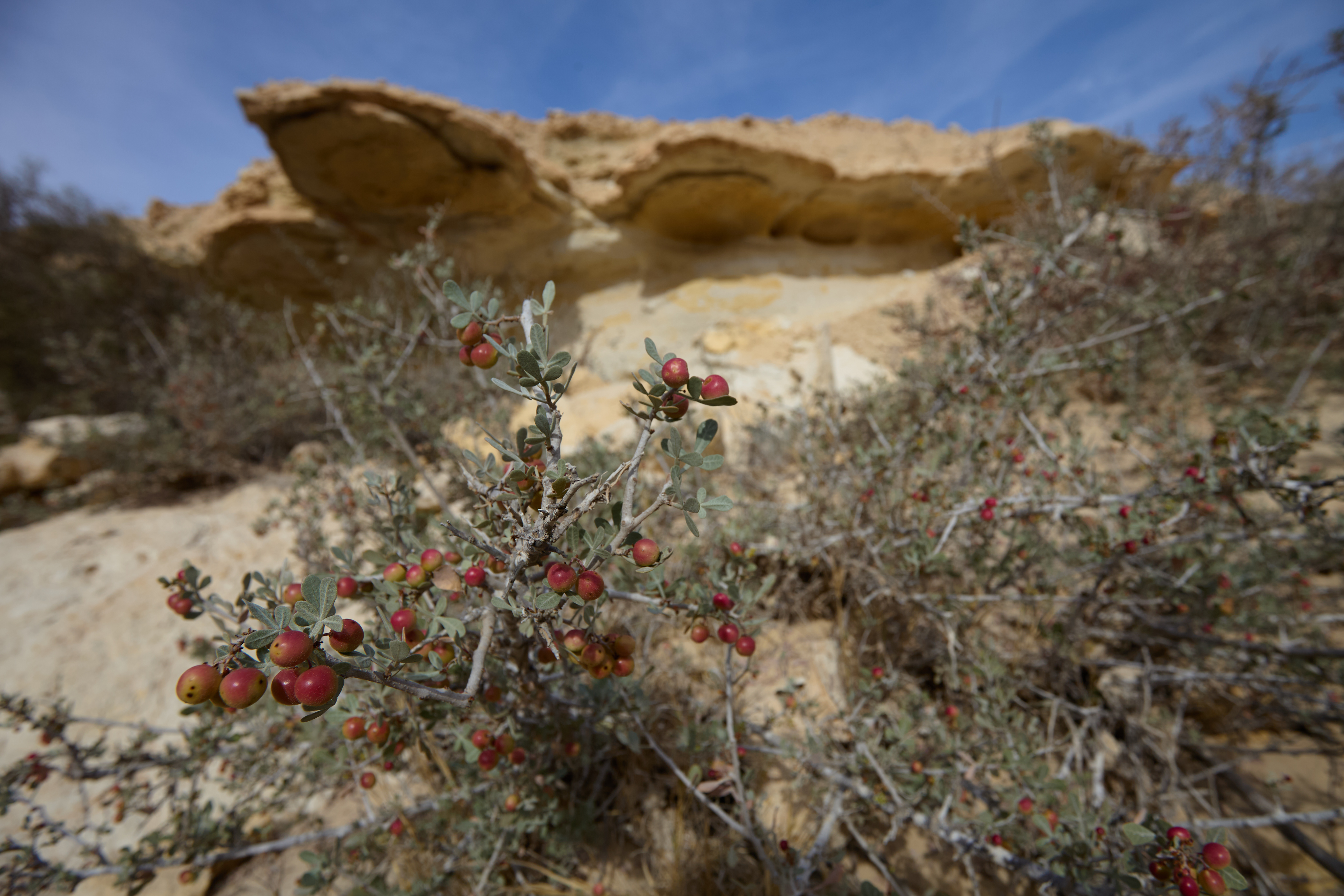
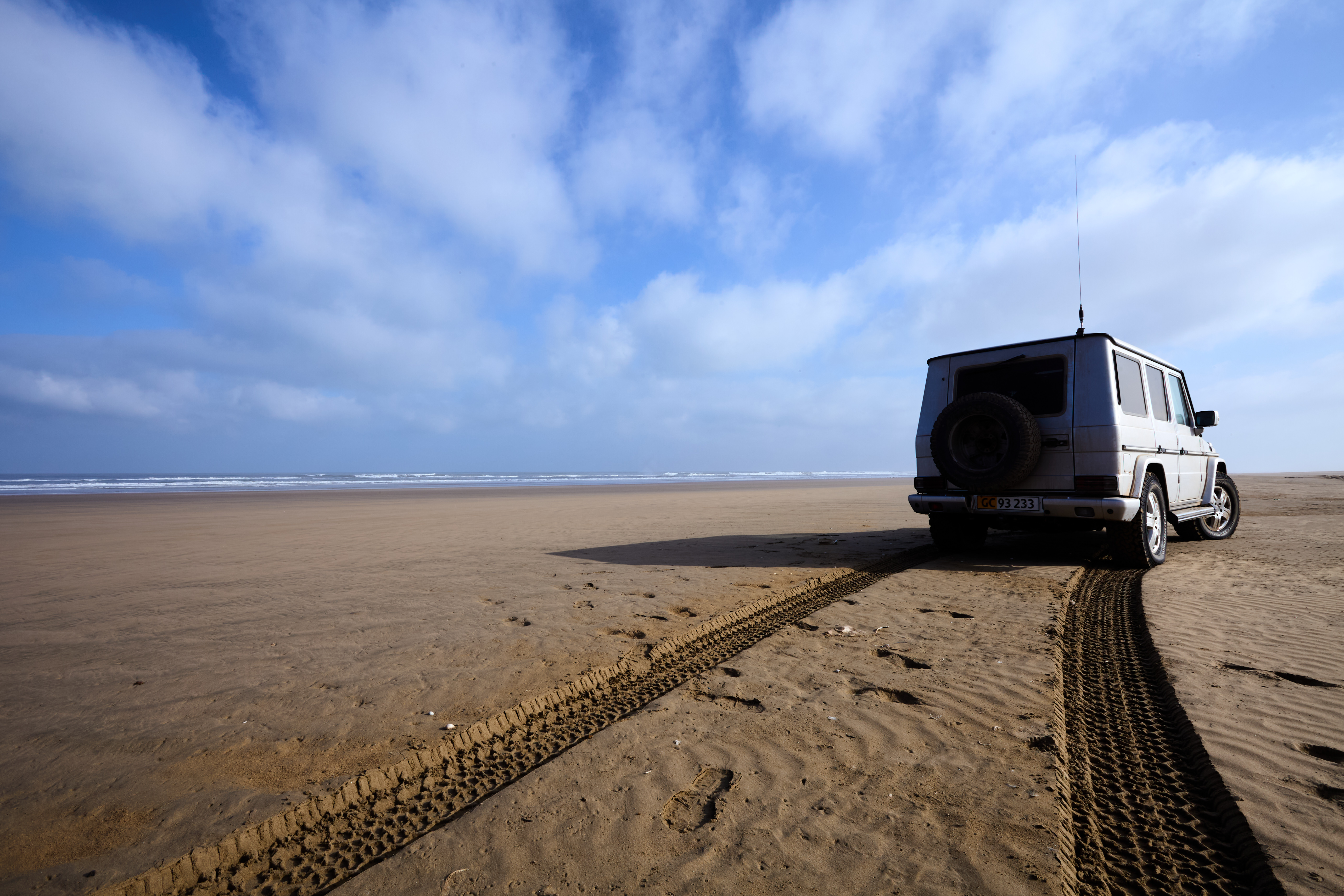
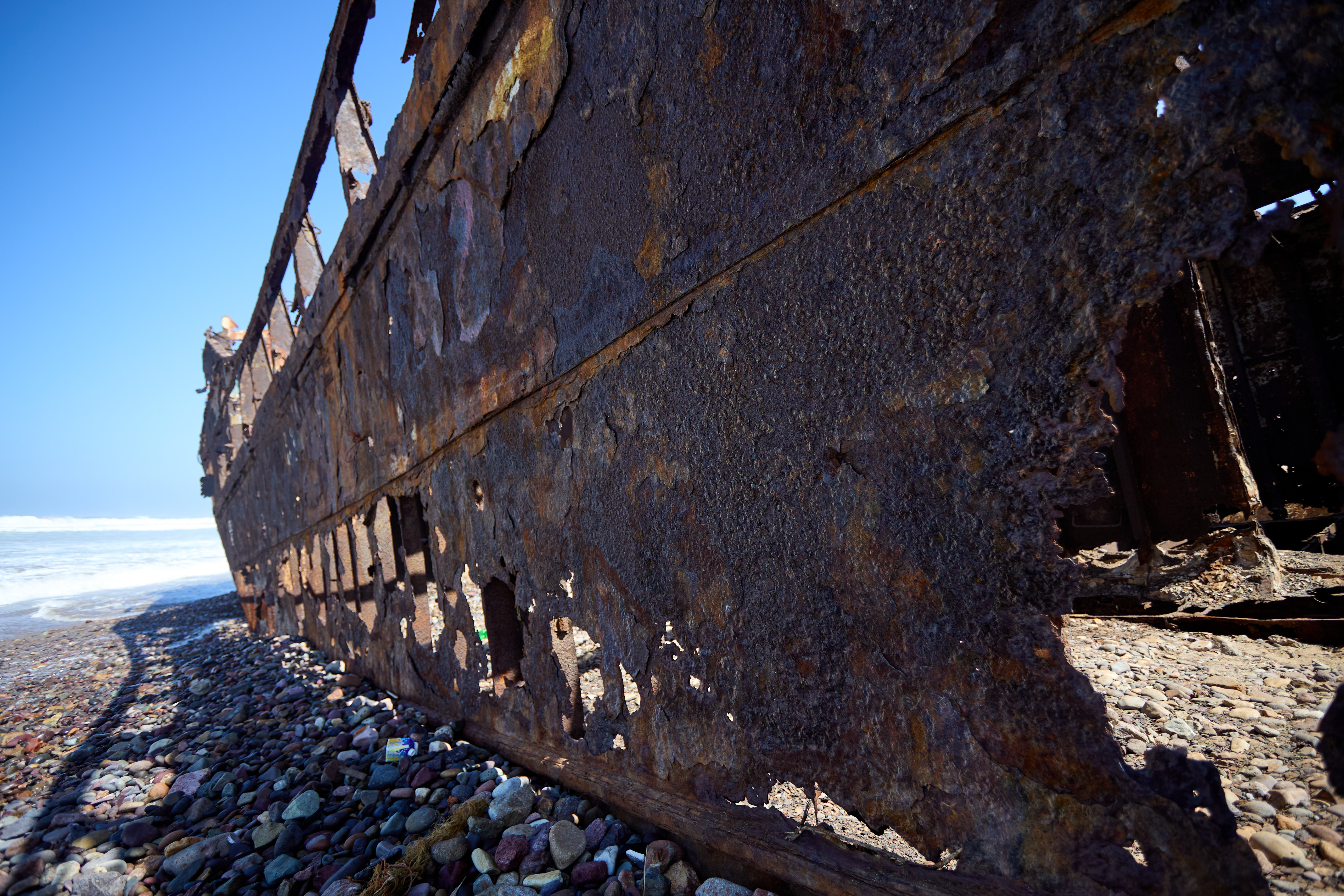

The next few days were used to travel back up north via the tarmac and a few occasional drives on the beach and also a detour off the main road inland with some nice unexpected extended true off-road drives to get to a nice place for a wild-camp north of Chebika, and the next day we were on Plage Blanche. The last three days we more or less back-tracked and used the same spots for wild-camping as on our way going south.
We totaled 3.945 km. in Morocco and the Western Sahara during our seventeen days there, it equals 232 km. per day, and the total drive time was 77 hours making it around 4,5 hours per day. I had four 20 liters Jerry-cans with me for additional fuel supply, and for the longest duration away from fueling stations I had to empty two of them. I also had three 20 liters Jerry-cans for drinking water, but could easily have gotten away with bringing only one or two. We did buy a pack of six 2 liters bottles of drinking water on a few occasions though and some Coca-Cola in order to try to keep our stomachs in good shape, which we succeed at by just buying bread and vegetables in the local markets. I had brought some meat, ham, chicken, cheese and some other food supplies with me from home in my 45 l. Engel fridge-freezer, it did not last for the entire duration of the trip so we had a few vegetarian dinner meals.
On my way back up through Europe I took some good time to drive on some of the smaller more scenic roads and I also drove though Andorra going from northern Spain into France, I had time for a short stopover at the skiing terrain in the Pyrenees, - seeing all that snow was a bit strange after have being in the sand, stone and rocks of the Sahara only a few days earlier. I more less had the same time-schedule driving home with a single overnight stay in southern Spain in the same campground when getting off the ferry in Tarifa, Spain from Tangers Med Port in Morocco, and one sleepover in northern Spain close to Andorra and then another additional one somewhere in central Germany, both times I slept in a parking lot on the Auto-route and Autobahn.
I reached my home before lunch and more or less went straight to bed, a bit tired but filled up with some great adventures, and that´s what it is all about I think. I had no issues with my Geländewagen and it performed exceptional well in the different situations we were in during the adventure. So I´m certainly holding on to that boxy lady.


